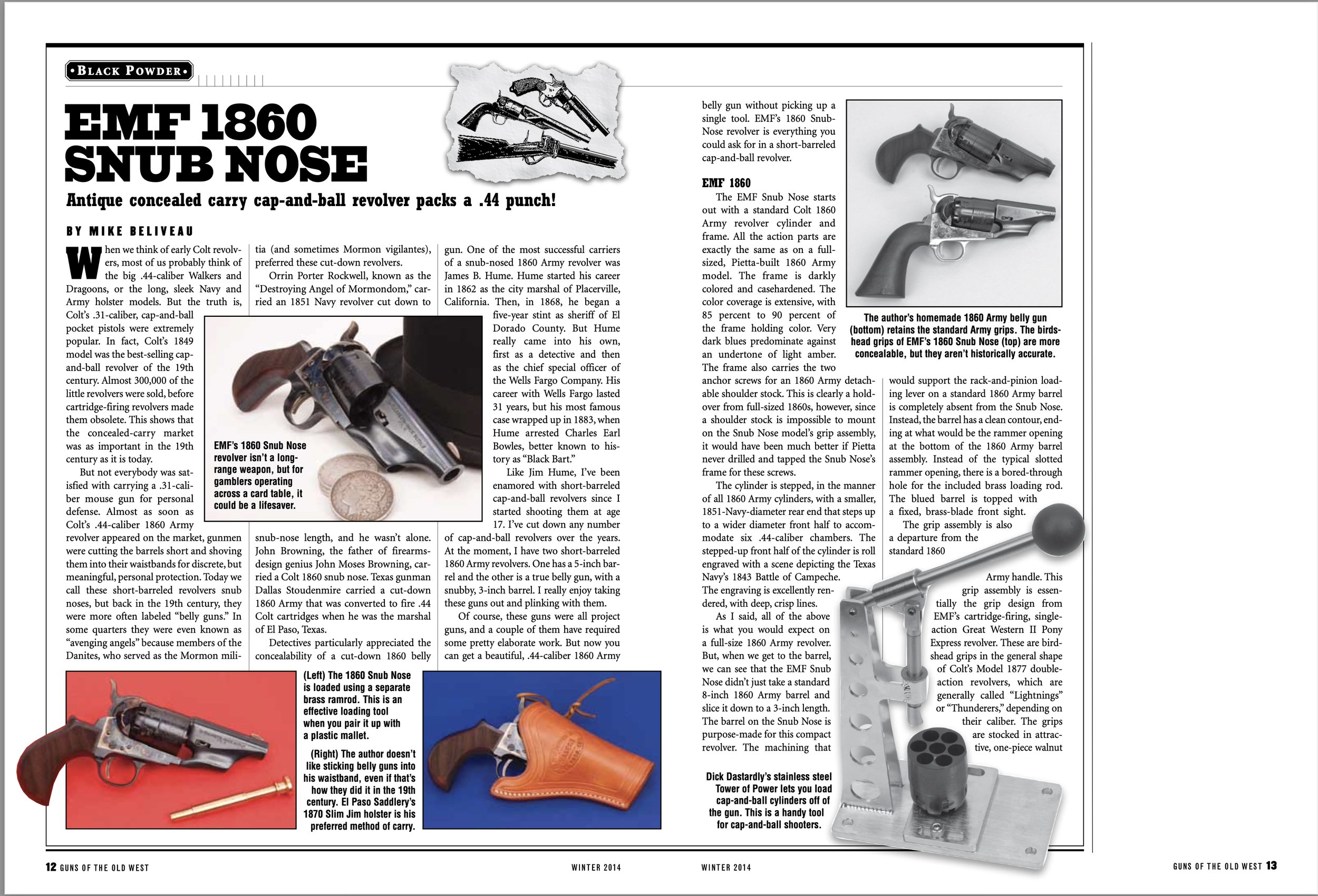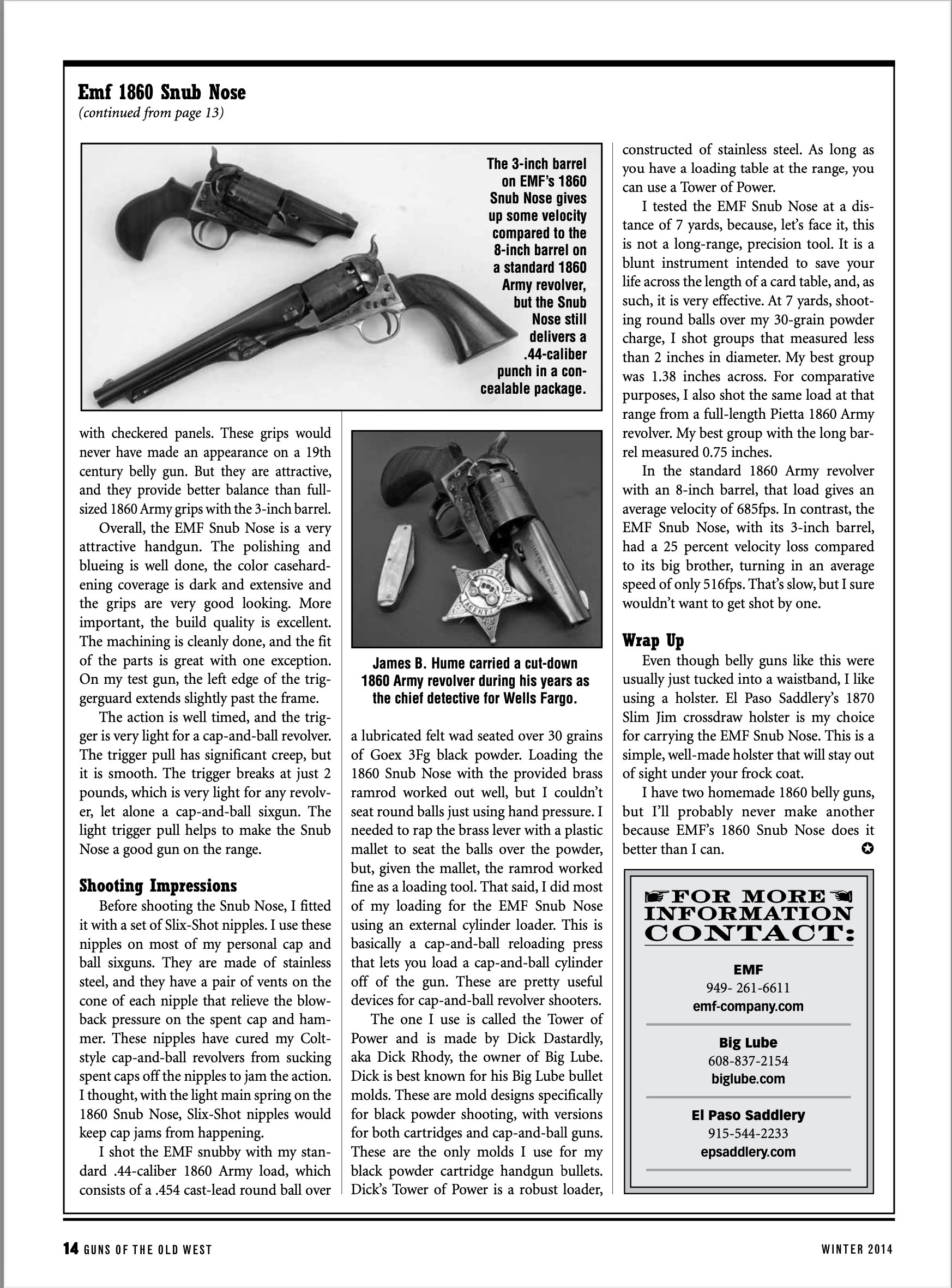E.M.F.’s Snub Nose 1860
A compact version of Colt’s classic Model 1860 Army revolver.
When we think of early Colt’s revolvers, most of us probably think of the big .44 caliber Walkers and Dragoons, or the long, sleek Navy and Army holster models. But the truth is, Colt’s .31 caliber, cap and ball, pocket pistols were extremely popular. In fact, Colt’s 1849 model was the best selling cap and ball revolver of the nineteenth century. Almost 300,000 of the little revolvers were sold, before cartridge firing revolvers made them obsolete. Which shows that the concealed carry market was as important in the nineteenth century as it is today.
But, not everybody was satisfied with carrying a .31 caliber mouse gun for personal defense. Almost as soon as Colt’s .44 caliber 1860 Army revolver appeared on the market, gunmen were cutting the barrels short and shoving them into their waistbands for discrete, but meaningful, personal protection. Today we call these short-barreled revolvers snub noses, but, back in the nineteenth century they were more often labeled “belly guns”, though in some quarters, they were known as “Avenging Angels” because members of the Danites, who were the Mormon militia, and sometimes Mormon vigilantes, preferred these cut down revolvers.
Orrin Porter Rockwell, known as the “Destroying Angel of Mormondom”, carried an 1851 Navy revolver cut down to snub nose length, and he wasn’t alone. John Browning, the father of firearms design genius John Moses Browning, carried a Colt 1860 snub nose. Texas gunman Dallas Stoudenmire carried a cut down 1860 Army that was converted to fire .44 Colt cartridges, when he was the marshal of El Paso, Texas.
Detectives particularly appreciated the concealability of a cut down 1860 belly gun. One of the most successful carriers of a snub nosed 1860 Army revolver was James B. Hume. Hume started his career in 1862 as the city Marshal of Placerville, California. Then, in 1868 he began a five-year stint as sheriff of El Dorado County. But Hume really came into his own, first as a detective, and then as the Chief Special Officer, of the Wells Fargo Company. His career with Wells Fargo lasted 31 years, but his most famous case wrapped up in 1883 when Hume arrested Charles Earl Bowles, better known to history as Black Bart.
Like Jim Hume, I’ve been enamored with short-barreled cap and ball revolvers since I started shooting them at age 17. I’ve cut down any number of cap and ball revolvers over the years. At the moment I have two short-barreled 1860 Army revolvers. One has a five-inch barrel, and the other is a true belly gun, with a snubby, three-inch barrel. I really enjoy taking these guns out and plinking with them.
Of course these guns were all project guns, and a couple of them have required some pretty elaborate work. But now you can get a beautiful, .44 caliber 1860 Army belly gun without picking up a single tool. E.M.F.’s 1860 Snub Nose revolver is everything you could ask for in short barreled cap and ball revolver.
The E.M.F. Snub Nose starts out with a standard Colt 1860 Army revolver cylinder and frame. All the action parts are exactly the same as on a full-sized, Pietta-built 1860 Army model. The frame is darkly color case hardened. The color coverage is extensive, with 85 percent to 90 percent of the frame holding color. Very dark blues predominate against an under tone of light amber. The frame also carries the two anchor screws for an 1860 Army detachable shoulder stock. This is clearly a hold over from full-sized 1860s, however, since a shoulder stock is impossible to mount on the Snub Nose model’s grip assembly, it would have been much better if Pietta never drilled and tapped the Snub Nose’s frame for these screws.
The cylinder is stepped, in the manner of all 1860 Army cylinders, with a smaller, 1851 Navy diameter, rear end that steps up to a wider diameter front half to accommodate six .44 caliber chambers. The stepped up front half of the cylinder is roll engraved with a scene depicting the Texas navy’s 1843 battle of Campeche. The engraving is excellently rendered, with deep, crisp lines.
As I said, all of the above is what you would expect on a full size 1860 Army revolver. But, when we get to the barrel, we can see that the E.M.F. Snub Nose didn’t just take a standard eight-inch 1860 Army barrel and slice it down to a three-inch length. The barrel on the Snub Nose is purpose made for this compact revolver. The machining that would support the rack and pinion loading lever on a standard 1860 Army barrel is completely absent from the Snub Nose. Instead the barrel has a clean contour ending at what would be the rammer opening at the bottom of the 1860 Army barrel assembly. Instead of the typical slotted rammer opening there is a bored through hole for the included brass loading rod. The blued barrel is topped with a fixed brass blade front sight.
The grip assembly is also a departure from the standard 1860 army handle. This grip assembly is essentially the Express Grips from E.M.F.’s Great Western II Pony Express cartridge firing single action revolver. These are birdshead grips in the general shape of Colt’s model 1877 double action revolvers, which are generally called ”Lightnings” or “Thunderers” depending on their caliber. The grips are stocked in attractive, one-piece walnut with checkered panels. These grips would never have made an appearance on a nineteenth century belly gun. But they are attractive, and they provide better balance than full-sized 1860 Army grips with the three-inch barrel.
Overall the E.M.F. Snub Nose is a very attractive handgun. The polishing and blueing is well done, the color case hardening coverage is dark and extensive, and the grips are very good looking. More important, the build quality is excellent. The machining is cleanly done, and the fit of the parts is great with one exception. On my test gun the left edge of the trigger guard extends slightly past the frame.
The action is well timed, and the trigger is very light for a cap and ball revolver. The trigger pull has significant creep, but it is smooth. The trigger breaks at just two pounds, which is very light for any revolver, let alone a cap and ball sixgun. The light trigger pull helps to make the Snub Nose a good gun on the range.
Before shooting the Snub Nose, I fitted it with a set of Slix Shot nipples. I use these nipples on most of my personal cap and ball sixguns. They are made of stainless steel, and they have a pair of vents on the cone of each nipple that relieve the blow-back pressure on the spent cap and hammer. These nipples have cured my Colt style cap and ball revolvers from sucking spent caps off the nipples to jam the action. I thought, with the light main spring on the 1860 Snub Nose, Slix Shot nipples would keep cap jams from happening.
I shot the E.M.F. snubby with my standard .44 1860 Army load, which consists of a .454 cast lead round ball over a lubricated felt wad seated over 30 grains of Goex 3Fg black powder. Loading the 1860 Snub Nose with the provided brass ramrod worked out well, but I couldn’t seat round balls just using hand pressure. I needed to rap the brass lever with a plastic mallet to seat the balls over the powder, but, given the mallet, the ramrod worked fine as a loading tool. That said, I did most of my loading for the E.M.F. Snub Nose using an external cylinder loader. This is basically a cap and ball reloading press that lets you load a cap and ball cylinder off of the gun. These are pretty useful devices for cap and ball revolver shooters.
The one I use is called the Tower of Power, made by Dick Dastardly, a.k.a. Dick Rhody, the owner of Big Lube LLC. Dick is best known for his Big Lube bullet molds. These are mold designs specifically for black powder shooting, with versions for both cartridges and cap and ball guns. These are the only molds I use for my black powder cartridge handgun bullets. Dick’s Tower of Power is a robust loader, constructed of stainless steel. As long as you have a loading table at the range, you can use a Tower of Power.
I tested the E.M.F. Snub Nose at a distance of seven yards, because, let’s face it, this is not a long range, precision tool. It is a blunt instrument, meant to save your life across the length of a card table. And, as such it is very effective. At seven yards, shooting round balls over my 30-grain powder charge, I shot groups that measured less than two inches in diameter. My best group was one and three-eighths inches across. For comparative purposes I also shot the same load at that range from a full-length Pietta 1860 Army revolver. My best group with the long barrel measured three quarters of an inch.
In the standard 1860 Army revolver with an eight inch barrel, that load gives an average velocity of 685 feet per second. In contrast, the E.M.F. Snub Nose, with its three-inch barrel, had a 25 percent velocity loss compared to its big brother, turning in an average speed of only 516 feet per second. That’s slow, but I sure wouldn’t want to get shot by one.
Even though, belly guns like this were usually just tucked into a waistband, I like using a holster. El Paso Saddlery’s 1870 Slim Jim cross draw holster is my choice for carrying the E.M.F. Snub Nose. This is a simple, well-made holster that will stay out of sight under your frock coat.
I have two homemade 1860 belly guns, but I’ll probably never make another because E.M.F.’s 1860 Snub Nose does it better than I can.
Specifications:
E.M.F. 1860 Snub Nose
Caliber: .44 cap & ball
Barrel: 3 inches
OA Length: 8 inches
Weight: 2 lbs 4 oz
Grips: One-piece checkered walnut
Sights: Fixed
Capacity: six rounds
Points of contact
E.M.F. Co. Inc.
1900 E. Warner Ave., Suite 1-D
Santa Ana, CA 92705
949- 261-6611
Dick Dastardly
1506 Clarmar Drive
Sun Prairie,WI 53590
(608) 837-215
El Paso Saddlery
2025 E. Yandell
El Paso, Texas 79903
915-544-2233

